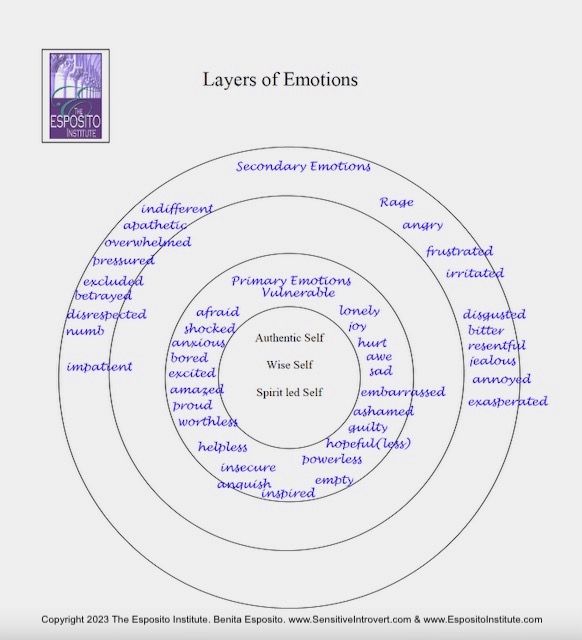5 Steps to Empower Successful Decision-making: Motivational Interviewing Part 2
I mentioned that we often want to give advice because we want to be helpful in part one of this Motivational Interviewing article. We are compassionate Highly Sensitive Introverts, and we want our loved ones’ pain to go away as quickly as possible. Sometimes advice-giving is helpful, but other times it fosters unhealthy codependency instead of personal empowerment. Giving advice can damage our relationships when people don’t want to be told what to do. They might perceive us as being controlling or condescending. When people get frustrated with our advice-giving, we need to stop and take a different tact. Read part one for more details.
Here, in part two of this Motivational Interviewing article, I’ll share five practical steps to facilitate clear decision-making which will help people experience true empowerment and raise self-confidence.
Here’s the Highly Sensitive super power for you to develop: Your role is to be a sounding board and a facilitator, not a problem-solver.
 Step 1: When a person talks about a problem, invite them to participate in a coaching dialogue. Tell them this is a special kind of conversation which will help increase their self-awareness, self-compassion, and effective solutions. Explain that you’ll be guiding the conversation to help them explore their options, but you won’t be giving advice. You won’t share your own problems. You’ll be holding sacred space so they can discover what is best for themselves.
Step 1: When a person talks about a problem, invite them to participate in a coaching dialogue. Tell them this is a special kind of conversation which will help increase their self-awareness, self-compassion, and effective solutions. Explain that you’ll be guiding the conversation to help them explore their options, but you won’t be giving advice. You won’t share your own problems. You’ll be holding sacred space so they can discover what is best for themselves.
First, ask for permission. Something like, “Would you like my help with this problem?”
If they say “yes,” tell them that you will help them explore their issue. You’ll help them catch their own fish for the day instead of catching fish for them. Together, decide how much time you want to devote to this conversation.
If they say, “No, I don’t need your help,” accept that answer. Back off gracefully. I know that may be hard to do, but please try your best. Handle your own reactive feelings that arise. Journal your self-talk and the interpretations that you make about yourself and them. Ask yourself if you know that your interpretations are accurate. Often, our self-talk is reactive. Be compassionate with yourself. Do your inner work. Our need to help others could be a cover-up for our own denied insecurities or sense of helplessness. I know that may be hard to hear. If you are attached to giving advice and have a difficult time letting go, a therapist can help you learn how to do motivational interviewing well.
 Step 2:
Step 2:
You’ll ask a series of questions to help your loved one explore their issue in step 3. I’m telling you step 2 now because I don’t want you to miss it.
(1) Summarize what they say each step along the way.
(2) Validate them and
(3) empathize to help them feel understood. Do this frequently throughout the entire process.
Empathy and compassion are gold. They build trust and help the person feel emotionally safe with you. Your loved one will know you hear them and that you take them seriously. They won’t feel the need to repeat themselves so often. They’ll feel more comfortable opening up and going deeper to access the heart of the problem. You must go deep to create effective solutions.
“We can not solve our problems with the same level of thinking that created them.” ~Albert Einstein
Here’s an example of summarizing, validating and empathizing. “I see how disturbing this issue is for you, and that you want help to get centered again. Your boyfriend dumped some heavy criticism on you and you feel devastated. That makes sense to me. I’m right here with you. Tell me more.”
Remember: Don’t take on responsibility for problem-solving. Put the ball in their court. You don’t have to figure out their problem. It’s not your job. It’s theirs. You help them find their own answers. When you do this well, you’ll see how empowered people will become. They’ll arrive at their own insights, and they’ll tend to follow through on decisions because they have a sense of ownership of the solutions.
–> I’m offering a one-time free group coaching session to help people learn Motivational Interviewing on Tuesday, May 9, 2023 at 8:00-9:00pm Eastern on Zoom. If you would like to join us, please fill out the Contact Form and mention this group. Registration closes Monday, May 8, 2023 at midnight.
 Step 3: Explore the issue with open-ended questions.
Step 3: Explore the issue with open-ended questions.
Ask them to describe the issue as specifically as possible. Here are a few of the powerful questions you can use.
- At what level does this issue bother you on a scale of 1-10 where 10 is high?
- What is the ideal way you would like to be at the end of our conversation?
- What are your emotions now?
- Ask about the secondary reactive emotions that arise immediately. (Share the diagram below to help them identify their emotions.)
- Then ask about the primary vulnerable emotions underneath. Secondary emotions cover up the tender emotions that we don’t feel comfortable sharing.
- Don’t push for vulnerable feelings unless the person feels safe with you and is well-grounded. Go one step at a time. Stay with them right where they are, even in the secondary emotions, validating and empathizing each step of the way..

Continue asking open-ended questions along with summarizing, validating and empathizing.
- Where do you feel your emotions in your body?
- What’s the physical sensation? Examples: My throat feels constricted. My chest feels pressure. My jaws are tight. My forehead hurts. (This helps them get grounded in their body.)
- What bothers you most about the issue?
- What consequences does this issue have in your life?
- What are your interpretations about the situation?
- What are your interpretations about the other person(s)?
- What are your interpretations about yourself? What do you say about yourself to yourself?
- Examine each interpretation and ask non-judgmentally: Do you know this to be true and accurate?
- What other interpretations could you make that are more accurate and healthier?
- What do you think is the root of this problem?
- What else do you think might be causing the issue?
- Anything else?
- Is there an event from your past that is related to this issue that might be affecting you?
Caution: People may become emotionally reactive during this process. They could have trauma flashbacks in which they can’t understand why they are so emotional. You may not be able to understand their emotional intensity either.
Stay calm and compassionate. Your calmness will help regulate their nervous system. Talk in a soothing voice. Coach them to take deep slow breaths. Breathe in to the count of 5 and breathe out to six. Some people like “box breathing.” Breathe in to 4, hold to 4, breathe out to 4, relax to 4. Repeat.Ask them to feel their feet on the floor. Guide them to alternate pressure between their right and left foot as they inhale and exhale.
Ask them to name five things they can see, hear, touch, smell, and taste. These processes will deactivate the flight-fight-freeze response and ground them.
After they self-soothe, continue with the conversation if they want to or stop. It’s up to them.
Consider helping your loved one find a therapist trained to help heal trauma.
 Step 4: Facilitate the solution-finding phase with open-ended questions.
Step 4: Facilitate the solution-finding phase with open-ended questions.
- What solutions can you think of?
- What’s another solution you can think of?
- Tune into your Wise Self. What does your Wise Self suggest?
- If they say I don’t know, say, “Give it a minute and see what comes up.”
- Imagine that a good friend has this same problem. What would you tell your friend?
- They answer and then you say, “How do you see yourself now?”
- What would your best friend tell you? How does your best friend see you? The person answers and then you say, “How do you see yourself now?”
- What would God, Jesus, Holy Spirit tell you? How do they see you? The person answers and then you say, “How do you see yourself now?”
- Let’s give it a minute. Pause and reflect on what comes up.
Select one solution at a time. Explore each possible solution and the possible outcomes.
- What do you think would happen if you tried this solution?
- Write down the pros and cons of the solution.
- If the person is stumped, ask, “Do you want to think about it and come back to me?” Name a time to reconvene: 20 minutes, two hours, or tomorrow at 1pm?
Note: If the person yes-but’s you, it means you have wandered out of your lane. Stop giving advice. Toss the ball back in their court. Ask the coaching questions again. Validate, empathize. Be compassionate.
At the very end after they have surfaced all the solutions they can think of, you might say, “Do you want my opinion or ideas?”
Only if they say yes, offer your idea for their consideration without thinking you are right or superior.
 Step 5: Encourage accountability.
Step 5: Encourage accountability.
Ask if they want to create an accountability system. Explain that an accountability buddy will help them be more successful. Who would they like to ask? You or someone else?
- What will they do and by when? Be specific.
- Develop a tracking system to monitor progress. Example: make a chart and put it on the refrigerator. Every time they complete a behavior, they stick a star on the chart.
- Set a review date in one week with their accountability buddy. What happened and what did they learn?
- Encourage an attitude of experimentation where they learn how to improve the outcomes step by step. Small changes over time create success.
- Mistakes and failures are natural in the learning process. Be non-judgmental.
- Repeat the entire process on a weekly basis until they have achieved their goal.
Summary
When you help people examine their issues, you support them to gain insight far beyond what you could have imagined. They feel empowered because the answers come from within themselves and from their spiritual connection.
You’ll feel fabulous because you helped your loved one to help themselves. You’ll feel less burdened by responsibility and less frustrated. It’s a win-win for everyone.
Motivational Interviewing helps people develop clear thinking and promotes decision-making abilities. You help them increase self-awareness and self-worth. They learn to catch their own fish instead of depending on you to catch fish for them. They are more likely to implement the solutions because they were actively involved in the decision-making process.
Your relationships will improve and creative solutions will blossom like flowers unfolding in the sunshine. Motivational Interviewing is an exciting process when you learn to do it well.
 Invitation for a Free HSP Group Coaching
Invitation for a Free HSP Group Coaching
Join me for a complimentary group coaching session to learn Motivational Interviewing. I’ll briefly review the skills, and then I’ll coach one participant in front of the group as a demonstration. Your learning will be deepened with the follow-up question-and-answer session.
When and Where: Zoom, one Tuesday, May 9, 2023 at 8:00pm-9:00pm Eastern. That’s 5:00-6:00pm Pacific.
Registration closes Monday, May 8, 2023.
If you would like to be coached in front of the group, briefly describe your challenge. I’ll select the topic that I believe is most appropriate for the group.
Please fill out the Contact Form and mention this group.
.
Contact Information
If you would like private confidential life coaching or spiritual counseling to efficiently resolve your issues, please reach out to me. You will receive a response Monday-Thursday to get the ball rolling.
Benita A. Esposito is the author of the bestselling book, The Gifted Highly Sensitive Introvert: Wisdom for Emotional Healing and Expressing Your Radiant Authentic Self, available on Amazon. She is a Licensed Professional Counselor in Georgia, Licensed Clinical Mental Health Counselor in North Carolina, and a life coach and spiritual counselor for Highly Sensitive Introverts worldwide.
Citation: Motivational Interviewing (MI) was developed by William R. Miller. The purpose of motivational interviewing is to help a person actively participate in the change process by tuning into their intrinsic motivation. It helps people resolve ambivalence so they can more effectively make decisions and act on them. The five pillars of MI are autonomy, acceptance, adaptation, empathy, and evocation.
Photo credits: Benita A. Esposito took these floral photos at Hamilton Gardens in Hiawassee, Georgia, the Southeast’s largest public collection of rhododendrons.





Leave a Reply
Want to join the discussion?Feel free to contribute!